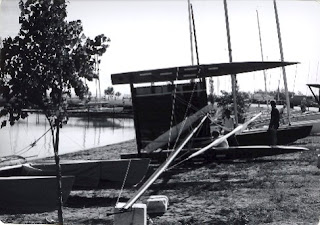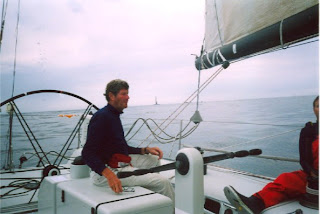 I started sailing with John Brown in 1962, on his Block Island 40 “Volta”. It was also the year of my first New York Yacht Club cruise. “Volta” won also everything during the cruise that year, what a way to start. I continued working on the boat as a summer job until 1967; after which I continued to commission and de-commission the boat for several more years.
I started sailing with John Brown in 1962, on his Block Island 40 “Volta”. It was also the year of my first New York Yacht Club cruise. “Volta” won also everything during the cruise that year, what a way to start. I continued working on the boat as a summer job until 1967; after which I continued to commission and de-commission the boat for several more years.
Author: ws lirakis
RIO 1972

In 1972 Following the Mediterranean Championships in Sardinia, I returned to Newport, won the Shields national championships with Joe O’Hora and George Brazil, and practiced for the Windsurfing worlds, that would take place in San Diego. Following the Windsurfing I joined “Charisma” in Rio de Janeiro, Brazil for the Rio circuit” styled after Admiral’s cup, three boat teams. Our team comprised of “Safari”, belonging to Paul Adams, “Sorcery” belonging to Jim Baldwin, and “Charisma”
Admiral’s Cup 1971
 Following our delivery across the ocean “Carina” was hauled out of the water at Camper & Nicholson’s yard in Gosport. it made sense because the first race, the Channel race started at Southend closeby. The team was comprised of “Yankee Girl”, “Bay Bea”, and “Carina” Bill Snaith, however was chosen to be the team captain, in Cowes without a boat.
Following our delivery across the ocean “Carina” was hauled out of the water at Camper & Nicholson’s yard in Gosport. it made sense because the first race, the Channel race started at Southend closeby. The team was comprised of “Yankee Girl”, “Bay Bea”, and “Carina” Bill Snaith, however was chosen to be the team captain, in Cowes without a boat.
more 1970
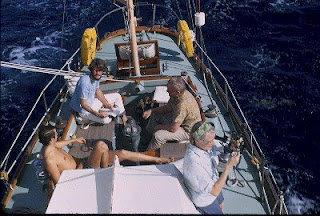

 In 1970 I sailed the intercollegiate championships in Madison, WI. In those days the team race championships were divided by district. We beat the West coast for the first time in many years; however in the individual championships they dominated.
In 1970 I sailed the intercollegiate championships in Madison, WI. In those days the team race championships were divided by district. We beat the West coast for the first time in many years; however in the individual championships they dominated.

Chicago-Mackinac 1980
In July of 1980 I was invited to sail the Chicago-Mackinac race aboard “Immigrant” a 47 foot Ed Dubois design, weighing 17,000 pounds; belonging to Bill McAteer. A very progressive and interesting boat to sail. My first experience sailing a boat with a short keel, requiring keen concentration to sail upwind. The wind did not free up until the end of the race building to 40 knots for the finish. We had a lively run in.
Boomerang
 I raced the 1978 and 1980 Bermuda Races on George Courmantarous’ “Boomerang” originally designed and built by Bob Derecktor, substantially modified by Scott Kaufmann. I also sailed several SORC on the boat. We were a mini-maxi at 66 feet. caught between the two size breaks. Sailing the boat to it’s optimum, we had brillant moments. George went on to have a long line of boats by the same name. Jeff Neuberth playing a big role in the organizing of those campaigns.
I raced the 1978 and 1980 Bermuda Races on George Courmantarous’ “Boomerang” originally designed and built by Bob Derecktor, substantially modified by Scott Kaufmann. I also sailed several SORC on the boat. We were a mini-maxi at 66 feet. caught between the two size breaks. Sailing the boat to it’s optimum, we had brillant moments. George went on to have a long line of boats by the same name. Jeff Neuberth playing a big role in the organizing of those campaigns.
1971 trans-atlantic
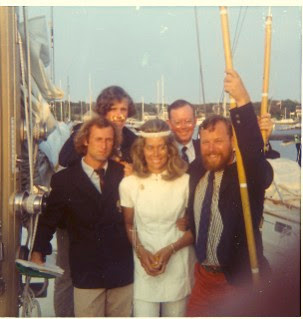 In 1971 we cruised “Carina” to England for the Admiral’s Cup and Fastnet Race. we sailed from Indian Harbor Yacht Club in Greenwich, Ct. to Harwichport, on Cape Cod; where David Steere the owner of “Yankee Girl” had a summer house, compound might be a better description. A big party the night of our arrival and we left across the ocean along with “Yankee Girl”, “American Eagle” owned by Ted Turner, and “Carina” belonging to Dick Nye.
In 1971 we cruised “Carina” to England for the Admiral’s Cup and Fastnet Race. we sailed from Indian Harbor Yacht Club in Greenwich, Ct. to Harwichport, on Cape Cod; where David Steere the owner of “Yankee Girl” had a summer house, compound might be a better description. A big party the night of our arrival and we left across the ocean along with “Yankee Girl”, “American Eagle” owned by Ted Turner, and “Carina” belonging to Dick Nye.


Tornado
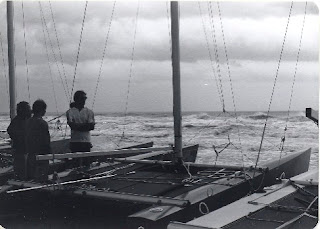
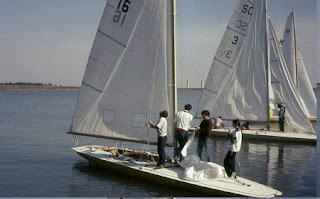 In 1977-1978 I teamed up with my college sailing friend Henry Bossett, to campaign a Tornado for the Olympics. I had sailed not only in college with Henry , but E Scows as well, still my favorite monohull.
In 1977-1978 I teamed up with my college sailing friend Henry Bossett, to campaign a Tornado for the Olympics. I had sailed not only in college with Henry , but E Scows as well, still my favorite monohull.
Fastnet 2003

 This was my fifth Fastnet Race,(My first was in 1969) I have a fondness for this race; the challenges of the tide gates, the weather, the changes and obstacles.The fireworks the night before, the charm and bustle of Cowes, contribute to this feeling.
This was my fifth Fastnet Race,(My first was in 1969) I have a fondness for this race; the challenges of the tide gates, the weather, the changes and obstacles.The fireworks the night before, the charm and bustle of Cowes, contribute to this feeling.




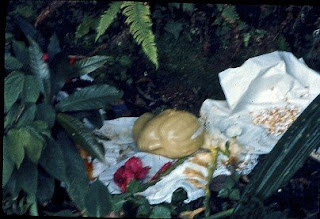




.jpg)
